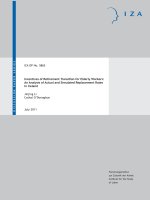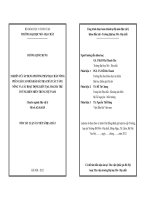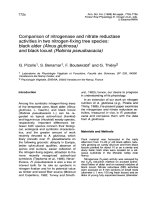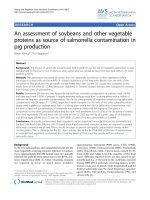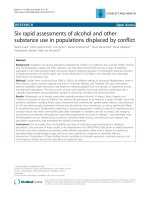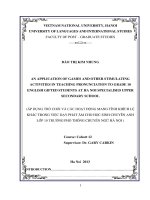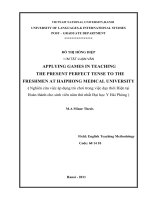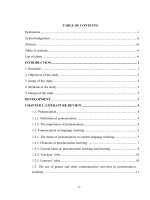An application of games and other stimulating activities in teaching pronunciation Áp dụng trò chơi và các hoạt động mang tính khích lệ khác trong việc dạy phá
Bạn đang xem bản rút gọn của tài liệu. Xem và tải ngay bản đầy đủ của tài liệu tại đây (1.03 MB, 76 trang )
iv
TABLE OF CONTENTS
Declaration i
Acknowledgement ii
Abstract iii
Table of contents iv
List of charts vi
INTRODUCTION 1
1. Rationale 1
2. Objectives of the study 2
3. Scope of the study 2
4. Methods of the study 3
5. Design of the study 3
DEVELOPMENT 4
CHAPTER 1: LITERATURE REVIEW 4
1.1. Pronunciation 4
1.1.1. Definition of pronunciation 4
1.1.2. The importance of pronunciation 4
1.2. Pronunciation in language teaching 5
1.2.1. The status of pronunciation in current language teaching 5
1.2.2. Elements of pronunciation teaching 7
1.2.3. Current ideas on pronunciation teaching and learning 8
1.2.4. Teachers‟ roles 10
1.2.5. Learners‟ roles 10
1.3. The use of games and other communicative activities in pronunciation
teaching 11
v
CHAPTER 2: METHODOLOGY 13
2.1. Context of the study 13
2.2. Participants of the study 14
2.3. Activities applied in the course 14
2.4. Instruments 18
2.4.1. Diagnostic test 19
2.4.2. Final oral examination 19
2.4.3. Questionnaire 19
2.4.4. Teacher‟s notes 20
CHAPTER 3: DATA PRESENTATION, ANALYSIS AND DISCUSSION 21
3.1. Quantitative results 21
3.1.1. Scores in diagnostic test and final oral exam 21
3.1.2. Responses to the questionnaire 22
3.2. Qualitative results - Teacher‟s notes and observations 31
3.2.1. Diagnostic Test Analysis 31
3.2.2. The researcher‟s observations during class time throughout the course 322
3.3. Discussion 34
3.3.1. The effectiveness of games and other stimulating activities 34
3.3.2. Some disadvantages of the use of games and other stimulating activities. 35
CONCLUSION 37
1. Conclusion 37
2. Implications 38
3. Limitations of the study and suggestions for further study 39
REFERENCES 40
APPENDICES
vi
LIST OF CHARTS
Chart 1: Students‟ scores in diagnostic test and final test
Chart 2: The role of pronunciation in language learning
Chart 3: The influence of pronunciation on speaking and listening
Chart 4: Students‟ evaluation of their own pronunciation
Chart 5: Students‟ evaluation of the difficulty of pronunciation
Chart 6: Students‟ interest in learning pronunciation
Chart 7: Students‟ effort in learning pronunciation
Chart 8: Students‟ self-studying time
Chart 9: Students‟ evaluation of pronunciation lessons
Chart 10: Students‟ evaluation of the effectiveness of pronunciation lessons
Chart 11: Students‟ evaluation of class activities
Chart 12: Students‟ preference of activities inside class
Chart 13: Students‟ preference of activities outside class
1
INTRODUCTION
1. Rationale
It is undeniable that English has become a language of global communication
thanks to its contribution to different fields of our life such as: science, technology,
aviation, diplomacy and so on. No one can deny that the rapid expansion of
information technologies and the spread of globalization have led to an explosion in
the demand for English worldwide.
English is now taught throughout of Vietnam in different levels of education
from primary schools to universities because it serves as an international language
and as a mean to promote mutual understanding and cooperation between Vietnam
and other countries. In fact, more and more people desire to know and master
English in order to keep them up-to-date with the global development. As a result,
English is taught not only at schools and universities but also at many foreign
language centres, on radio, television and even via the internet. However, both
teaching and learning of English are still far from being satisfaction. One main
problem is that most Vietnamese learners are rather good at English writtenly but
not orally. Many of them have a good command of grammar and vocabulary, which
promises very high marks in written tests, but cannot communicate successfully
with foreigners. The reason lies in the imbalanced development of four language
skills. In most schools and universities (except those whose major is English),
teachers focus too much on reading and writing rather than speaking and listening
of which pronunciation is a good foundation. Thus, students do not often have
English competence, especially in oral communication.
In the present context of teaching and learning English at English
Department, HANU, speaking and listening are very important for first year
students because they establish a firm base for students‟ further development,
especially in interpreting skills. In recent years, the department has taken teaching
and learning pronunciation into consideration because it is a paramount feature of
speaking and listening.
Being a teacher of English in general, and pronunciation in particular at
English Department, HANU, I am well aware of the importance of pronunciation to
2
help my students improve these skills, but like other teachers, I have faced many
difficulties in creating motivation so that students are eager to practise in and out of
their classes. After two years teaching pronunciation separately from speaking to
first year students, we have realized that the class time is not enough for our
students to have great improvement. However, just few students are motivated and
spend time self-studying. Thus, even though we have tried our best in class, our
students still have a lot of problems in pronunciation, which badly affects their
speaking and listening skills.
We have questioned ourselves about how to motivate our students to
maximize their time of practising in class and even outside class, which leads to the
use of games and other stimulating activities. We have tried activities collected
from different sources, which seems to bring about great effect. However, we just
have the feeling but not a specific study on how effective they are. Therefore, I have
conducted an action research on the application of games and other activities in
teaching pronunciation to first year students at English Department, HANU in order
to investigate the effectiveness and to help other teachers choose suitable activities
for their classes.
2. Objectives of the study
The study is aimed at:
Finding out their advantages and disadvantages.
Helping pronunciation teachers choose suitable activities for their classes.
Thus, this thesis is to answer two research questions:
How effective is the use of games and some other stimulating activities?
What are students‟ attitude towards the use of games and some other
stimulating activities?
3. Scope of the study
To create motivation for students in pronunciation classes, teachers at
English Department, HANU, have applied a lot of games and activities. However,
the researcher in this study only focuses on and analyzes some typical ones (which
will be presented in the following parts) and then suggests some effective activities
that teachers can introduce to students so that they have more practice outside class.
3
There are 10 first year classes which consist of 250 students who have to take
pronunciation as a compulsory subject; however, this action research was carried
out in only two classes of which the researcher was in charge. Thus, the
questionnaire was delivered to only 50 participants. Additionally, the study was
conducted in only 12 of the total 32 weeks of pronunciation teaching.
4. Methods of the study
Action research is the method employed in this study. To achieve the aims
mentioned above, the researcher has used a number of instruments to collect data
for analysis which include a questionnaire distributed before the term started and
after it ended, teachers‟ observation and notes, an oral diagnostic test, and end-of-
term test.
5. Design of the study
This minor thesis is composed of three parts.
Part 1, INTRODUCTION, presents the rationale, aims, scope, methods and
design of the study.
Part 2, DEVELOPMENT, is divided into three chapters.
Chapter 1, Literature Review, presents relevant concepts to pronunciation
and pronunciation teaching.
Chapter 2, Methodology, involves the information about context, participants
and instruments of the study.
Chapter 3: Data Presentation, Analysis and Discussion, focuses on data
analysis to show students‟ point of view towards pronunciation and the
effectiveness of different activities.
Part 3, CONLUSION, summarizes some major findings, provide
implications for pronunciation teaching, limitation of the study and suggestions for
further research.
4
DEVELOPMENT
CHAPTER 1: LITERATURE REVIEW
1.1. Pronunciation
1.1.1. Definition of pronunciation
There are various ways to define pronunciation. Macmillan Dictionary gives
an easy-to-understand definition, that is “the way in which a word or language is
pronounced”.
Similarly, Oxford Advanced Learner‟s Dictionary defines pronunciation as
the way in which a language or a particular word or sound is pronounced or the way
in which a particular person pronounces the words of a language.
More specifically, pronunciation can be understood as one of the three
explanations given in the :
The act or manner of pronouncing words; utterance of speech.
A way of speaking a word, especially a way that is accepted or generally
understood.
A graphic representation of the way a word is spoken, using phonetic
symbols.
According to Adult Migrant English Program Research Centre,
pronunciation refers to the production of sounds that we use to make meaning. It
includes attention to the particular sounds of a language (segments), aspects of
speech beyond the level of the individual sound, such as intonation, phrasing, stress,
timing, rhythm (suprasegmental aspects), how the voice is projected (voice quality)
and, in its broadest definition, attention to gestures and expressions that are closely
related to the way we speak a language.
It is obvious that the four sources above do not have the same way to define
pronunciation but they share a common knowledge that pronunciation is how words
or sentences are spoken.
1.1.2. The importance of pronunciation
Nowadays, no one can deny the significant role of pronunciation in language
teaching and learning. Pronunciation is one of the most important aspects of
language. We may be proficient at grammar and have a huge store of vocabulary,
5
but if we pronounce words wrongly, we just will not get understood.
Wong (1993) argues that the importance of pronunciation is even more
distinct when the connection between pronunciation and listening comprehension is
considered. As listeners expect spoken English to follow certain patterns of rhythm
and intonation, speakers need to employ these patterns to communicate effectively.
If the rhythm and intonation are different, listeners simply can‟t get the meaning.
Similarly, listeners need to know how speech is organized and what patterns of
intonation mean in order to interpret speech accurately. Thus, learning about
pronunciation develops learners‟ abilities to comprehend spoken English.
Furthermore, Wong demonstrated that a lack of knowledge of pronunciation could
even affect students‟ reading and spelling.
Varonis and Gass (1982) examined the factors affecting listening
comprehension in native speakers of English exposed to foreign or second language
accents. They concluded that grammar and pronunciation interact to influence
overall intelligibility.
As indicated above, it is surely that pronunciation plays a very important role
in communicative competence because successful communication can not take
place without correct pronunciation (Celce-Murcia, Briton and Goodwin, 1996).
1.2. Pronunciation in language teaching
1.2.1. The status of pronunciation in current language teaching
The status of pronunciation teaching in different schools of language
teaching has varied widely. According to Castillo (1990), pronunciation teaching
has no role at all in the grammar-translation method, but it is the main focus in the
audio-lingual method. The audio-lingual view of the pronunciation class was also
mirrored in situational language teaching, developed in Britain (Richards and
Rodgers, 1986). During the late 1960's and the 1970's questions were asked about
the role of pronunciation in the ESL/EFL curriculum, whether the focus of the
programmes and the instructional methods were effective or not. Pronunciation
programmes until then were 'viewed as meaningless non-communicative drill-and-
exercise gambits' (Morley, 1991). Purcell and Suter (1980) claimed that the
teaching of pronunciation was pushed aside in many language programmes and
6
many studies concluded that little relationship exists between teaching
pronunciation in the classroom and attained proficiency in pronunciation. They also
found out that the strongest factors that affect pronunciation seem to have little to
do with classroom activities'
Nowadays, teachers and learners have realized the importance of
pronunciation in English teaching and learning, however, it still has not received
enough attention. In fact, pronunciation tends to be de-emphasized in most English
courses because many teachers believe that pronunciation cannot be taught
effectively and it is not worth spending time on this field because it should be
allowed to develop naturally by students.
Although Morley (1991) insisted that it is necessary to teach English
pronunciation in the ESL or EFL classroom, this important area is still neglected at
many universities and colleges around the world. According to Michael Wei, in
China, there is no place for English phonetics courses in English teaching and
learning and a pronunciation course is still only an elective in the universities or
colleges. According to Lin, Fan and Chen (1995) some teachers in Taiwan might
argue that English pronunciation is not important at all, for very few tests would
require students to show abilities related to pronunciation or speaking. Michael Wei
also pointed out that in the U.S., many students and teachers believe that it is
useless spending time on pronunciation because it would be difficult, if not
impossible for students to hear differences. English pronunciation is simply ignored
in the curriculum of some universities in Thailand (Wei and Zhou, 2002). In
Mexico, pronunciation was described as “the Cinderella of language teaching”; that
means an often low level of emphasis was placed on this very important language
skill (Dalton, 2002).
As mentioned above, pronunciation is still neglected in EFL/ESL classrooms
throughout the world including Asia today. In reality, this ignorance has been
noticed by few teachers of ESL/ EFL who have recently provided valuable
empirical articles with model techniques and activities that help to improve
pronunciation in and outside class. Till now, new ways of teaching pronunciation
are still developed and tested, then there is still a need for careful experimentation to
determine the effectiveness of methods.
7
1.2.2. Elements of pronunciation teaching
Different researchers have different points of view toward what should be
taught in pronunciation classes. Colin Mortimer (1985) claimed that elements of
pronunciation teaching include weak forms, clusters, linking-up, contractions and
stress time. However, according to Gerald Kelly (2000), teaching pronunciation
involves: vowels, consonants, word and sentence stress, intonation, other aspects of
connected speech and spelling. Jennifer Jenkins (2004) provided more
comprehensive elements of pronunciation teaching. This researcher stated that
depending on the second language in question, pronunciation teaching typically
covers any or all of the following: consonant and vowel sounds, changes of these
sounds in the stream of connected speech, word stress patterns, rhythm, and
intonation, which might be described as the nuts and bolts of pronunciation.
Consonant and vowel sounds
It is obvious that learners of English need to know and pronounce letter
sounds correctly because they are the basement for the combination of sounds into
words. However, students must know that English pronunciation does not match
spelling and one of the most confusing aspects of English pronunciation is sound
and spelling patterns. English has borrowed lots of words from other languages such
as ancient Latin, Greek, Eskimo and Farsi, so its sound and spelling
correspondences are irregular. Thus, phonetic transcription is an indispensable part
of pronunciation teaching.
Word stress patterns
Word stress must highly be focused on at the beginning of any pronunciation
courses because without correct word stress, speakers of English cannot have
understandable pronunciation. In every two or more-syllable words, one of the
syllables is stressed, which means it is higher, louder and longer than the others.
This stressed syllable is very important because it helps listeners distinguish the
word from others. Therefore, listeners often find it hard to understand what the
speaker is saying when he or she misuses word stress.
8
Rhythm
Rhythm is the obvious feature of every language. Rhythm or beat of a
language is the product of word stress and the way in which important items are
emphasized. The combination of strong beats (the occurrence of important items)
and weak beats (the occurrence of unimportant items) makes rhythm easy to be
recognized. Thus, after dealing with word stress patterns, teachers of pronunciation
should introduce to their students the rhythm of English which is characterized by
the alteration of strong and weak syllables (Kenworthy, 1987).
Intonation
Even if you pronounce each word clearly, if your intonation patterns are non-
standard, your meaning will probably not be clear. Also, in terms of comprehension,
you will lose a great deal of information if you are listening for the actual words
used. Intonation refers to the intention and feelings of the speaker. An important
feature of English intonation is the use of an intonational accent (and extra stress) to
mark the focus of a sentence. That is the reason why students need to have good
knowledge of sentence focus in order to have good intonation. Moreover, intonation
is an abstract concept which can be vague to students while sentence focus is more
specific. With sentence focus, speakers help listeners easily get the message they
want to convey. In spoken English, speakers often put stress on the words that carry
the most information. In other words, they use stress to signal the importance of
different parts of the message. As a result, listeners need to be able to realize points
of focus; otherwise, they will feel difficult to interpret what they hear. Teachers will
succeed in teaching sentence focus if they select suitable contexts in which learners
find it easy to understand the notion of “importance”.
1.2.3. Current ideas on pronunciation teaching and learning
Changing outlooks on language learning and teaching have influenced the
view of language competence, which leads to a shift from specific linguistic
competencies to broader communicative competencies as goals for teachers and
students (Morley, 1991). Previously, teachers of pronunciation only focused on
teaching segmental features which started with a concentration on phonetic
alphabets during the Reform Movement (Celce-Murcia et. al., 1996). Phonetic
9
training was used in order to help learners establish good speech habits. Minimal
pair drills were used extensively to distinguish phonemes in listening practice and
oral production (Celce-Murcia et. al., 1996). However, after Anderson-Hsieh
introduced the researches on “Teaching suprasegmentals to international teaching
assistants using field-specific materials” (1990) and “Pronunciation factors affecting
intelligibility in speakers of English as a foreign language” (1995), the focus of
pronunciation teaching shifted dramatically from segmentals to an emphasis on
suprasegmentals. Following Anderson-Hsieh, abundant researches have
investigated the extent to which suprasegmentals contribute to speakers‟
intelligibility and its pedagogy. Underhill (1994) stressed the necessity of designing
syllabuses mainly focusing on major features of communication - superasegmental
features of speech for teaching English. McNerney and Mendelsohn (1992, p. 186)
suggested “a short-term pronunciation course should focus first and foremost on
suprasegmentals, as they have the greatest impact on the comprehensibility of
learners‟ English”. So far a lot of books for teachers have largely encouraged the
teaching of suprasegments at the production level to improve learners‟
intelligibility. In the same spirit, Morley also states the need for the integration of
pronunciation with oral communication, a change of emphasis from segmentals to
suprasegmentals, more emphasis on individual learner needs, meaningful task-based
practices, development of new teacher strategies for the teaching, and introducing
peer correction and group interaction. According to Cohen (1977), teaching
phonemes is not enough for intelligibility in communication. With the emphasis on
meaningful communication and Morley's (1991) premise, that 'Intelligible
pronunciation is an essential component of communication competence' teachers
should include pronunciation in their courses and expect students to do well in
them. It is certain that the learner's ability to communicate is severely limited
without adequate pronunciation skills. Morley believes that not attending to a
student's pronunciation needs „is an abrogation of professional responsibility
(1991)'.
Other research gives support to Morey's belief in the need for 'professional
responsibility' when the results show that 'a threshold level of pronunciation in
English such that if a given non-native speaker's pronunciation falls below this
10
level, he or she will not be able to communicate orally no matter how good his or
her control of English grammar and vocabulary might be' (Celce-Murcia, 1987).
Gilbert (1984) believes the skills of listening comprehension and pronunciation are
interdependent: 'If they cannot hear English well, they are cut off from the
language. If they cannot be understood easily, they are cut off from conversation
with native speakers.' Nooteboom (1983) has also suggested that speech perception
has great influence on speech production; the hearer has become an important factor
in communication discourse. This illustrates the need to integrate pronunciation
with communicative activities; to give the student situations to develop there
pronunciation by listening and speaking. The current research and the current trend
reversal in the thinking of pronunciation shows there is a consensus that a learner's
pronunciation in a foreign language needs to be taught in conjunction with
communicative practices for the learner to be able to communicate effectively with
native speakers.
1.2.4. Teachers’ roles
Some researchers (Suter and Purcell, 1980) have cast doubt on the
importance of pronunciation teaching because in their opinion, little relationship
exists between teaching pronunciation and attained pronunciation proficiency. They
stated that “the attainment of accurate pronunciation in a second language is the
matter substantially beyond the control of educators”. However, other researchers
including Pennington (1989) believed that teachers with formal training in
pronunciation play an important role in helping students improve their
pronunciation. A teacher of pronunciation often fulfills the following roles:
Helping learners perceive sounds
Helping learner make sounds
Creating authentic activities and exercises
Providing learners with feedback
Accessing learners‟ progress
1.2.5. Learners’ roles
There is no doubt that whatever the teacher does and however hard he/ she
tries, there is still no success in the teaching and learning process if students do not
11
involve. Students need to develop awareness and monitoring skills that will allow
learning opportunities inside and even outside the classroom environment, which
promises their improvement and prospect of change. The learner‟s involvement in
the learning process has been noted as one of the best techniques for developing
learner strategies, that is, the measures used by the learner to develop his language
learning (Morley, 1991). Thus, students must become part of the teaching and
learning process, actively involve in their own learning. Ultimate success in
pronunciation surely depends on learners‟ attitude and how much attempt they put
into the process of learning.
1.3. The use of games and other communicative activities in pronunciation
teaching
As discussed above, pronunciation is an essential part in language learning
and teaching. Many people believe that in language learning, effort is required at
every moment and must be maintained over a long period of time. It is also
obviously true with pronunciation learning. There are a few pronunciation teachers
who think that teaching pronunciation means helping students perceive and produce
English sounds correctly. That is why they often ask their students to repeat the
sounds times and times again after introducing them, which makes students get
bored with studying pronunciation. Once students get bored, they will get nothing
from the studying.
Talking about the advantages of games, Thiagarajan (1999); Wright,
Betteridge, & Buckby (2005) claimed that games add interest to what students
might not find very interesting. Sustaining interest means sustaining effort. After
all, learning a language involves long-term effort because games offer students a
fun-filled and relaxing learning atmosphere. Thanks to that, they learn and practise
the sounds in a non-stressful way. Games ease the fear of negative evaluation, the
concern of being negatively judged in public, and which is one of the main factors
inhibiting language learners from using the target language in front of other people
(Horwitz, Horwitz and Cope, 1986). In a game-oriented context, anxiety is reduced
and speech fluency is generated, so communicative competence is achieved.
According to Shalley Vernon in the article “Teaching English Pronunciation
Using Role Playing and Other Games”, anxiety is one of the most common
12
obstacles to the ESL students‟ ability to learn English pronunciation. However, the
problem of anxiety can also be resolved with games because students will learn to
relax and enjoy themselves, which encourages them to participate and be more
willing to experiment with new different sounds. Richard-Amato (1988) and
Uberman (1998) also shared the same view that the variety and intensity that games
offer may lower anxiety and encourage shyer learners to take part especially when
games are played in small groups.
More importantly, it is undeniable that games are advantageous in
pronunciation teaching in the way that they help teachers to create contexts in which
the language is useful and meaningful. Games provide a context for meaningful
communication. Even if the game involves discrete language items, such as a
spelling game, meaningful communication takes place as students seek to
understand how to play the game and as they communicate about the game: before,
during, and after the game (Wright, Betteridge, & Buckby, 2005). In order to take
part in games, learners must understand what others are saying and they must speak
in order to express their own point of view or give information. By that way,
teachers are successful in helping learners achieving the shift from specific
linguistic competencies to broader communicative competencies and the change of
emphasis from segmentals to suprasegmentals which have been presented clearly in
part 1.3.
Apart from games, other communicative activities such as drama practice,
puppet-play, news reading, and video making which sometimes require preparation
before going to class are also effective in pronunciation teaching because they are
very motivating even outside class and yield opportunities for students to put what
they have learnt in pronunciation lessons into connected speech. Thus, they will
experience what have been taught more vividly, therefore, remember better.
Games and other communicative activities, from what have been discussed
above, undoubtedly bring about a lot of benefit to both teachers and students in the
process of teaching and learning pronunciation. Thus, nowadays, it is obvious that
thousands of teachers all over the world are exploring those activities from different
printed and online sources to apply in their pronunciation classes with hope that
they can help their students gain the greatest improvement in this subject.
13
CHAPTER 2: METHODOLOGY
2.1. Context of the study
The study was carried out in two first year classes at English Department,
HANU. To tell the truth, English proficiency of students here is much lower that
that of previous years because they have easier access to the Department with lower
marks at the entrance exams.
However, the Department is still one of the best places for those who want to
be good interpreters and teachers of English. There are normally 10 or 11 first year
classes with about 25 students in each class. Most students here come from different
Northern provinces such as Bac Giang, Thai Nguyen, Bac Ninh, Thai Binh, and
Nam Dinh where they get used to passive ways of learning, which is embedded
deeply in their mind from primary school. Frankly speaking, they have had more
difficulties in learning English than students from big cities in terms of ability and
condition. Moreover, almost all students here have had no training in listening and
speaking, especially in pronunciation. However, when they are in English
Department, HANU, they have a favorable English learning environment because
they can work with qualified teachers, have more access to resources of reference
books in the library or via the internet, and more chance to meet foreigners. Thus, a
good way to enhance students‟ improvement is to motivate them to make most use
of all the external conditions to self study.
With the main purpose of training students to have high communicative
competence, the Department realizes that teaching and learning pronunciation play
an important role in the training process. Therefore, the subject has been taught
separately from Speaking for three years. There is a pronunciation team including
two American experts and five Vietnamese teachers who work with first year
students two periods per learning session, one learning session per week. There are
12 weeks in the first semester and 20 weeks in the second one. Teachers in the team
share their observation and ideas on the lesson plans as well as students‟ reaction in
the weekly meeting. The core book is English Pronunciation in Use – Elementary
by Mark Hancock, Cambridge University Press. Other extra materials are taken
14
from Primary Pronunciation Box by Caroline Nixon and Michael Tomlinson,
Targeting Pronunciation by Susan F. Miller, Understanding English pronunciation
by Susan Boyer, Pronunciation games by Mark Hancock.
The study was conducted in 12 weeks from October to December, 2010.
2.2. Participants of the study
The participants of this study were selected on the basis of convenience. I
was in charge of teaching pronunciation to two first-year classes 5A-10 and 6A-10
at English Department, HANU. Each class consists of 25 students, with 23 females
and 2 males ranging from 18 to 22 years of age. All of them had learned English for
at least 3 years and had to take the English written test designed by the Ministry of
Education and Training in the entrance exam to the university. However, their
marks were various, which shows that they were not of the same levels of English
proficiency. As presented above, most of the students come from Northern
provinces. In general, their grammar and reading are comprehensible, but their
pronunciation is not good. Besides the students in these two classes, the teacher also
contributed a lot to the study as her note and observation played an important role in
the analysis of the study.
2.3. Activities applied in the course
After two years teaching pronunciation to first year students at English
Department, HANU, I have realized that my students were not really motivated and
enthusiastic to practice inside and outside classes. That fact, of course, led to little
improvement in their pronunciation. Thus, when doing this action research, I have
applied some games and stimulating activities to encourage them to make more
effort in this subject.
Games
Most of the games applied in my classes are taken from the book
“Pronunciation Games” by Mark Hancock. I have chosen some games that were
suitable for my students when they practised individual sounds, word stress,
sentence stress and intonation (Appendix 8). All the games were used in classes at
different stages of the lesson.
15
Besides, I have also designed some other games that drew much attention
and interest from my students.
Teacher vs. Class
- Material: One set of cards, on each card, there is one word which is familiar
but commonly mispronounced; make cards out of the game words (Appendix 9)
- Rules: Teacher (T) raises one card for each student to pronounce. If that
student says it correctly, the whole class has 1 point. Otherwise, the T has 1 point.
Every student in the class will take turns to do this until the end to see who wins the
game.
- Notes: T is expected to win but don‟t forget to encourage students (Ss). At
the end of the game, T should stress that the ultimate purpose of the game is to
show Ss the difficulty of pronunciation
Single Sounds
- Material: 6 sets of cards, each set has 44 cards. On each card, there is one
sound (Appendix 10)
- Rules: T divides class into 6 groups. Each group gets one set of card. T
gives Ss 2 min to revise all the sounds. Then, T will pronounce one sound at a time
and the groups will have to raise the correct symbol for that sound. The group who
raises the CORRECT symbol the QUICKEST will get one point. At the end, the
group with the most points will be the winner.
- Notes: T should ask one student (S) to act as assistant to ensure fairness. T
should be very careful and accurate in his/her own pronunciation.
“Match and Sort”
- Materials: A set of syllables for each group of four (Appendix 11)
- Rules: Ss must combine stressed syllables with unstressed ones to make
two-syllable words (not longer). Tell them that the highlighted syllable (grey
background) must be the stressed syllable for that word. When they make a word,
they write it on a piece of paper in one of two columns: stress on first or stress on
second syllable (write on white board). Then they can put those two pieces of paper
(syllables) back in the bag or envelope. T checks groups individually and ask each
S to pronounce some of the words. In the end, ask which column had the most
16
words. They will see that, by far, there are many more words stressed on the first
syllable. Have individual Ss say different words.
“Same Stress”
- Material: A set of cards for each group (Appendix 12)
- Rules: Divide class into teams of four, one of the Ss in each group deals the
cards out evenly to each member of the group. They must hold them face down in
one hand. When T says “Begin”, one S in each group goes first by putting his top
card, word up, in the center of the table and pronouncing it. Then the next student
does the same thing on top of the first person‟s card. When there are 2 stress
patterns in a row that are the same, the first person to say “SAME!” gets to take all
the cards in the center pile and put them at the bottom of his own pile. If someone
yells “SAME!” but the stresses are actually different, then that person must put one
extra card at the bottom of the pile. The game continues this way until time is up.
- Notes:
Any person in the group can yell out “SAME!” Whenever he first
notices that the top two cards have the same stress pattern, even if it is
before the card thrower pronounces his word.
If someone uses incorrect pronunciation, tell the other Ss to help
correct it.
If someone yells “SAME!” and it is not the same stress, then he must
put a card of his on the center pile as penalty.
If someone runs out of cards, they can still yell “SAME!” and join in
the game again
Other stimulating activities
Sounds in focus
- Rules: T asks Ss to work in pairs and make up sentences or stories which
include some particular sounds in focus. (/i:/ and // for example) T then calls some
Ss to read their sentences or stories to see who has the most given sounds and who
has the most interesting products. (Appendix 13)
e.g.: There is a very big sheep licking milk and eating some meat in a pink
ship.
17
- Note: This activity can be used in class or assign as homework.
Poem composing
- Rules: T tells Ss a particular rhyme of a poem and then makes the first
sentence that includes the rhyme. T then points at a S at random; that S must create
and read aloud the next sentence of the poem. If the S cannot make a sentence, T
calls another one. (Appendix 14)
- Note: This activity can be assigned as homework with Ss working in pairs
or groups.
News reading
- Rules: T asks Ss to work in groups of three or four to write a news report
on what has happened around them in their imagination. Then, one representative
from each group read aloud the news in front of the class. The class vote for the
most interesting news. (Appendix 15)
- Note: This activity can be used in class or assigned as homework
Puppet-play
- Materials: Puppets (Attached VCD)
- Rules: T asks Ss to work in groups of three or four to act in the role of
different puppets. Ss have to think of the conversation among the puppets and after
some time for preparation, they will go to the board and use the puppets to present
to conversation.
Subtitle reading
- Materials: Short video clip or extracts of films, computer or VCD player, a
large screen, a projector, and speakers.
- Rules: T plays the clips or extracts twice with sound and English subtitles.
Ss look at the screen and listen to the sound to feel the intonation and emotion.
Later, T calls some Ss to be closer to the screen to read the subtitles while s/he is
playing the clips or extracts without sound.
- Note: The language and the speed of speaking in the clips or extracts must
be of Ss‟ level.
18
Lyrics completing
- Materials: CD of English songs, CD player, copies of the lyrics with some
gaps (Appendix 16)
- Rules: T plays the song, Ss listen to the song twice and fill in the gaps
individually. T then asks for Ss‟ answers and gives feedback. Finally, T plays the
song again, Ss listen and sing along.
- Notes: This activity can be adapted to Lyric Correction if the lyrics of the
songs had some changed words pronunciation of which is similar to the original
ones‟. Ss listen to the song and correct the wrong words.
Video making
- Materials: Computer or VCD player, a large screen, a projector, and
speakers (Attached VCD).
- Rules: Ss work in groups of maximum six members. They have to make the
plot by themselves and practise acting in their own play. Ss then videotape their
play in which each member has to speak at least some sentences. Ss hand in their
play at the end of the term so that T can show to the whole class. Ss then vote for
the most interesting one with the best pronunciation.
- Notes: This activity is a minor project of the term. T must assign the project
some weeks before the term ends so that Ss have enough time for preparation.
2.4. Instruments
In order to obtain in-depth information on the application of activities in the
course, the study used a variety of research instruments including an oral diagnostic
test, questionnaire, classroom observation and teacher‟s notes, and final
examination. There are a number of reasons why I chose these tools in my study. I
carried out the oral diagnostic test because it would give me true information on my
students‟ pronunciation before I decided which fields to focus on during the whole
course. The final examination was really necessary because it was an effective tool
to measure my students‟ improvement. The result of the final examination worked
as a good reference to see how much they had gained after the course. Besides the
two tests, I used questionnaire because it was easy to manage and obtain big-scale
data. Questionnaires are familiar to most people and nearly everyone has had some
19
experience completing questionnaires, so they generally do not make people
apprehensive. Moreover, questionnaires reduce bias. There is uniform question
presentation and no middle-man bias. The researcher's own opinions will not
influence the respondent to answer questions in a certain manner. Thus, the
questionnaire would give me more reliable data for analysis. Lastly, I applied
classroom observation and teacher‟s notes because it was convenient for the teacher
to obtain more detailed and precise evidence of the students‟ attitude and classroom
atmosphere. Additionally, it would permit the researcher to study the processes of
education in naturalistic settings. Classroom observation also stimulated change and
verified that the change occurred, which led to improved understanding and better
models for improving teaching.
2.4.1. Diagnostic test
At the beginning of the term, participants were required to take an oral
diagnostic test in which students read aloud a passage. The test was designed by the
two American experts and revised by five Vietnamese teachers. Students‟
performance was recorded for analysis of the pronunciation mistakes so that I
would pay more attention to their problems later in the course. The results of the
diagnostic test were also used in comparison with the results of the final
examination to reveal improvements that students made during the course of
pronunciation. (Appendix 1)
2.4.2. Final oral examination
The examination took place one week after the course. Students took the
exam in pairs, each pair had to read aloud a conversation in five versions which
were of the same level of difficulty (Appendix 2). Teacher marked students‟
pronunciation basing on the Test Rubric (Appendix 3). The examination was to find
out how much students had gained after the first term studying pronunciation.
2.4.3. Questionnaire
The questionnaire was delivered to students before and after the course. The
purpose of the two deliveries was to find out the students‟ attitude, interest and
motivation before the course and the changes in the students‟ self evaluation after
the course. (Appendix 5)
20
2.4.4. Teacher’s notes
The researcher carried out classroom observation in order to take notes of
changes in the students‟ attitude, motivation, interest and improvement during the
course. The researcher also reflected on the teaching and learning process after each
lesson.(Appendix 7)
21
CHAPTER 3: DATA PRESENTATION, ANALYSIS AND DISCUSSION
This action research was conducted to evaluate the application of games and
other stimulating activities in teaching pronunciation to first year students in
English Department, HANU. The main purpose is to investigate whether the
activities were effective to increase students‟ intelligibility and motivation in
learning pronunciation. This chapter presents the results of all the data gathered
throughout the research. Both quantitative and qualitative methods were used in the
collection of information reported in this chapter. Quantitative results involved in
participants‟ scores in diagnostic test, final oral exam and their responses to the
questionnaire. Qualitative results were the information taken from the researcher‟s
notes and observation.
3.1. Quantitative results
3.1.1. Scores in diagnostic test and final oral exam
0%
5%
10%
15%
20%
25%
30%
5
5.5
6
6.5
7
7.5
8
8.5
9
Diagnostic test
Final test
Chart 1: Students’ scores in diagnostic test and final test
It was found out that the overall scores of the students changed a lot in the
diagnostic test and final examination. In the diagnostic test, the results ranged from
5 to 9 with the average score of 6.52 while the results in the final test were various
from 6 to 9 with the average score of 7.44. Moreover, the percentage of students
who got a certain mark in the diagnostic test and the same mark in the final test was
totally different. Those with mark 6 accounted for the largest part (24%), followed
by the number of those with mark 6.5 and 7 (20%) at the beginning of the course. It
22
is obvious that students‟ pronunciation at that time was still very poor, which was
illustrated by the fact that 20% of them just got 5 and 5.5 in the test while only 14%
got the results of 8 and above. However, the results at the end of the course were
much more positive. None of the students scored 5 or 5.5 and the number of those
who scored 8 and above increased significantly by 16% to 30%. The majority of the
students got 7 or 7.5 (54%) in the final test compared to 22% in the diagnostic test.
More specifically, students with mark 7 made up the largest percentage of all
(30%).
The researcher‟s anecdotal notes in tests and examination revealed that after
the course students showed much improvement in pronouncing consonant sounds
although some needed further practice. The problem of word stress seemed to be
solved quite successfully with the habit of using dictionary and motivating
activities, which was illustrated by the fact that the number of the students who put
stress on the correct syllable increased considerably. Despite that positive finding,
sentence stress and intonation were still the problems for many students and they
needed much more practice on these aspects.
3.1.2. Responses to the questionnaire
Areas of investigation
The questionnaire includes 12 questions which cover five main areas of
investigation as follows:
Area of investigation
Question
Students‟ evaluation of the importance of pronunciation
Question 1, 2
Students‟ evaluation of their aptitude to learn
pronunciation
Question 3, 4
Students‟ evaluation of their interest and motivation
Question 5, 6, 7
Students‟ evaluation of pronunciation lessons
Question 8, 9
Students‟ evaluation of activities in the course
Question 10, 11, 12
Analysis and findings
Students‟ evaluation of the importance of pronunciation
